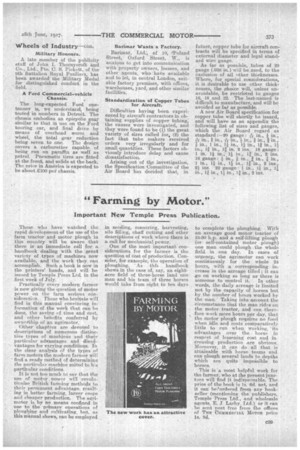"Farming by Motor."
Page 9

If you've noticed an error in this article please click here to report it so we can fix it.
Important New Temple Press Publication.
" Those who have watched the rapid development of the use of the farm tractor and motor plough in this country will be aware that there is an immediate call for a handbook dealing With the great variety of types of machines now available, and the work they can accomplish. Such a hook is now in the printers' hands, and will be issued by Temple Press Ltd. in the first week of July.
Practically every modern farmer is now giving the question of motor power on the farm serious consideration. Those who hesitate will find in this manual convincing information of the work that canbe done, the saving of time and oost, and other hebefits conferred by ownership of an agrinmtor.
Other chapters are devoted to descriptions of numerous distinctive types of machines and their particular advantages and disadvantages for varying conditions. In the clear analysis of the types of farm motors the modern farmer wilt ' find a ready method of determining the particular machine suited to his partinular conditions.
It is not too much to say that the use of motor newer will revolutionize British fartning methods to their permanent advantage, resulting in better farming. larger crops and cheaper production. The agrimotor is by no means confined in use to the primary operations of ploughing and cultivating, but, as this manual shows, can be employed in seeding, manuring, harvesting, silo filling, chaff cutting and other descriptions of work where there is a call for mechanical power. .
One of the Most important considerations for the farmer is the question of cost of production. Consider, for example, the operation of ploughing. As thrs handbook shows in the case of, say, an eightacre field of three-horse land one man and his team of three horses would take from eight to ten days
to complete the ploughing. With an average good motor tractor of 25-30 h.p. and a self-lifting plough (or seff-contained motor plough) one man could plough the whole field in one day. In cases of urgency, the agrimotor can work continuously for the whole 24 hours, with a, corresponding increase in the acreage tilled ; it can .go on working so long as there is someone to .control it. In other words, the daily acreage is limited not by the capacity Of horses but by the number of hours worked by the man. Taking into account the circumstance that the man rides on the motor tractor, and can therefore work more hours per day, that the motor plough requires no food when idle and costs comparatively little to run when working, •its advantages over the horse in respect of lessening cost and increasing production are obvious. Moreover, it can do all that is attainable with horse teams and can plough several lands to depths which are quite impossible to horses.
This is a most helpful work for the farmer, who at the present juncOre will find it. indispensable. The . price of the book is is. 6d. net, and it can bOorclered from any bookseller (mentioning the publishers, Temple Press Ltd., and wholesale
agents, E. J. Larby, or it can be sent post free from the offices of TIM COMMERCIAL MOTOR. price 1s. 8d.




















